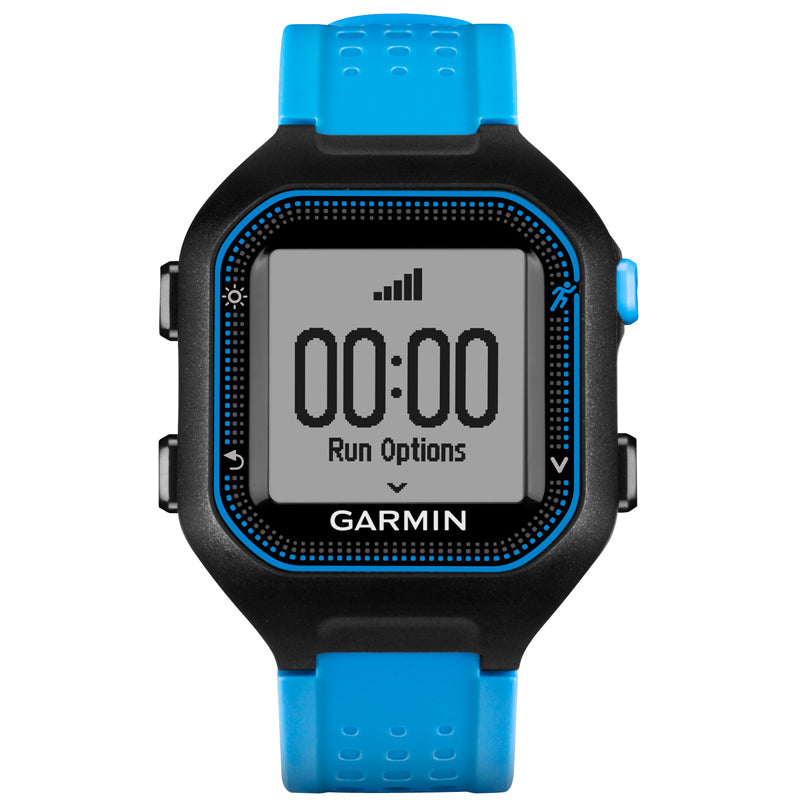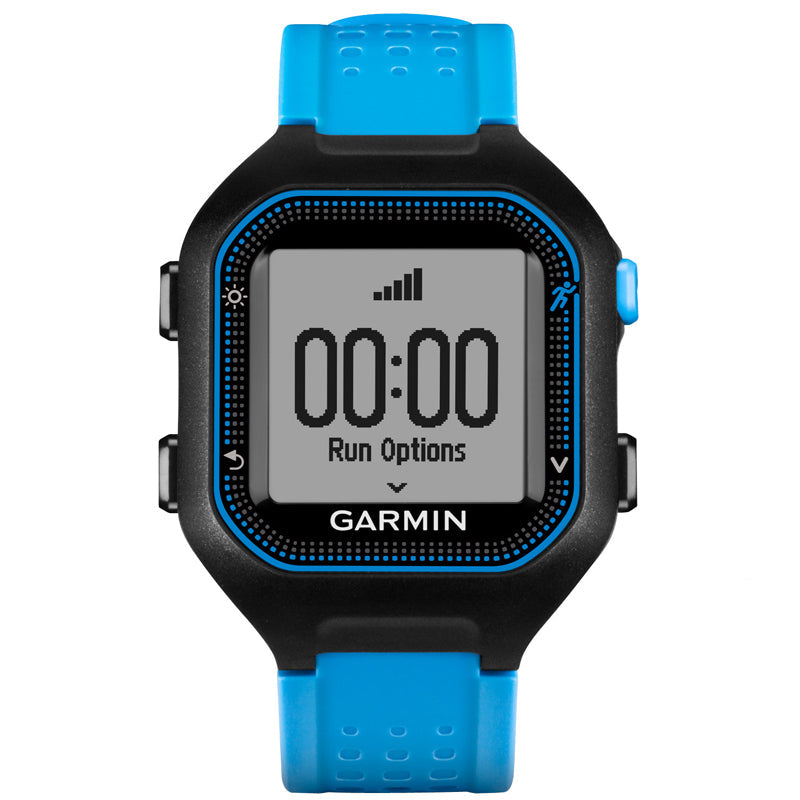Garmin Forerunner 25 GPS Running Watch
- HASSLE-FREE SUBSIDISED RETURNS within 30 Days
- FREE DELIVERY on Orders Over £49.99
- EXTENDED Christmas Returns Poicy
Garmin Forerunner 25 GPS Running Watch - Black/Blue / One size fits all is backordered and will ship as soon as it is back in stock.
Couldn't load pickup availability
Description
Description
Features
- Tracks distance, pace and calories
- Instantly share runs and activity tracking progress with friends, family and the world via social media by pairing a compatible device
with Garmin Connect™ Mobile - Activity tracking counts steps and calories and reminds you when it’s time to move
- Up to 8 hours of battery life with GPS on or 5 weeks in watch/activity tracking mode(small watch)
- Up to 10 hours of battery life with GPS on or 10 weeks in watch/activity tracking mode(large watch)
- Save, plan and share your activities at Garmin Connect™
Returns Info
Returns Info
SUBSIDISED TRACKED RETURNS SERVICE
If you intend to return any items, please use the Royal Mail Returns service to create a tracked label, then print this off and attach it to your parcel
Please access our ROYAL MAIL TRACKED RETURNS portal Click Here.
We provide subsidized tracked returns for £3 for up to 2 items. For more than 2 items, a fee of £6 will apply.
When sending your item back for a refund, the subsidised charge will be deducted from your refund.
When sending your item back for an exchange, the subsidised charge will be deducted from your payment card.
Please indicate whether you request an exchange or a refund using the provided Returns Form – these are packaged with every order, so please complete this and include it (or download The Running Outlet Returns Form PDF here).
Alternatively, if customers choose to return their order using an alternative return method, please return to the following address:
The Running Outlet
26 Burgate,
Canterbury,
Kent,
CT1 2HA,
UK
therunningoutlet.co.uk is not liable for returned items lost in transit when using the Royal Mail portal. Refunds will only be issued once the item has been successfully delivered to the store.
Become a member & get 10% off!
Buying Guide
Buying Guide
Picking the right shoe for you.
Consider coming into a store and doing a video gait analysis. Gait analysis monitors your body’s movement and your feet (sports biomechanics) whilst running. It’s commonly used to help athletes run more efficiently and to identify movement related problems for people with injuries who are seeking new running shoes.
During gait analysis you will be asked to walk and run on our in-store treadmill whilst your movements are recorded using the latest Daftfish software. A slow-motion, detailed analysis will show and explain your biomechanics, specifically looking at pronation, the inward-turning movement that occurs when your foot touches the ground. During walking and running this acts as cushioning for the body.
Everyone’s gait is slightly different, but there are four main types of running styles and pronation:
- Neutral Pronation
- Over Pronation
- Under Pronation, also known as Supination
- Forefoot runners
It’s very important to know your running gait so that we can advise and fit the correct shoes according to your own individual requirements.
Can’t get into store? Try a wet foot test
Step onto a piece of heavy duty paper, card or even a bathroom tile and look at the footprint you leave behind. Seeing how much of the sole is visible in the footprint will help you determine the type of arch you have and which category of shoe you will need to buy.
Flat: A flat footprint indicates that your aches are flat and therefore will need support. As your foot hits the ground your arch collapses in order to absorb the impact. If your arch collapses excessively, this is called overpronation and can lead to the ankle rolling excessively which over time causes some runners to develop pain. Overpronation in the arch can affect the whole body and cause discomfort in the heel, ankles, achilles tendons, shins, outside knee, outer hip, as well as the arches.
Normal: A normal footprint would indicate that the arches are high and therefore offer the neural support a runner needs. A neutral shoe makes up roughly 80% of available running shoes and have the same level of cushioning in the heel and the forefoot making it suitable for a large section of runners.
High: A high arch would indicate supination, the opposite to overpronation. The runner’s arch does not collapse very much at all which can lead to less shock absorption. This will concentrate the force of the impact toward the outside area of the forefoot leading to some runners that supinate experiencing foot pain or even stress fractures as a result. Runners that supinate may want to consider a highly cushioned neutral running shoe. The greater level of cushioning in these shoes can help absorb more of the shock from impact.
Size is important
When choosing a running shoe always consider the sizing. As you run, the blood goes into the foot causing it to naturally swell. If there isn’t enough room for the foot to breathe then it will cause friction against the inside of the shoe and eventually lead to blisters. We advise a thumb width at the front of the shoe, from the tip of your big toe to the end. If you are running up to a half marathon we would advise going up a half a size to your normal shoe size. If you are running further than a half marathon or training for a marathon then it would be advisable to go up a whole size. Having plenty of room will also make the shoe feel much more comfortable.
Seasoned runner – if it’s not broken why change?
If you have had a good experience with your old shoes and have stayed injury free then you might, understandably, be reluctant to change brand or model. Be sure to look at the latest version of your current shoe as most popular styles tend to be slightly tweaked rather than completely redesigned when updated. The fit and feel is always very similar if not exactly the same. It’s evolution rather than revolution!
Wear and Tear
Why do you need to replace your running shoes if they still look unworn? The simple fact is that a running shoe will act as a shock absorber for your muscles and joints through its cushioning. This cushioning will usually last for approximately 500 miles. After this, it compresses and then more shock is being put through the body and this can lead to muscle fatigue and injuries. The most obvious sign that a shoe has reached the end of its life is wear and tear. Flatter or smoother tread is one of the clearest indicators that it might be time for a replacement. The wear on your shoes can give an indication of your natural gait. If the upper has split near the toe box you might want to consider going up a half a size or in some cases, change the width of your shoes. For example, a standard width in a men’s shoe is a D width but the 2E width will be wider around the bridge and forefoot allowing the foot more room and therefore not creating friction that leads to the upper splitting and not supporting the foot correctly.
Comfort is KEY!
If your new shoes aren’t comfortable then you won’t enjoy running in them. You have a unique shaped foot and all brands are different in the design, shape and fit. It is advisable to pop to your local running specialist and try on a few different brands, on the treadmill if possible, to get a feel for the shoes. If you can’t get to a local store, wear them around the house for around 30 minutes to give you an idea of the fit and feel before running outdoors.
Sizing Advice
Sizing Advice
It's normal for your feet to swell slightly when running, especially over longer distances. We recommend ensuring your running shoes have enough room to account for this and to allow your toes to spread comfortably, by leaving approximately a thumbs width of space between the end of your longest toe and the front tip of the shoe. This will help to reduce the risk of bruised toenails, blisters or numbness.
Running shoe sizes can vary slightly from brand to brand but we generally advise wearing at least half a size bigger than your regular shoe size. If you run longer distances than a half marathon then a whole size can be needed.
Clothing sizes are a personal choice, remember to reference the size guides to check the own brands sizing measurements.




